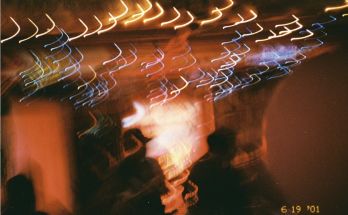Growing up, Scottish brothers Michael Sandison and Marcus Eoin loved playing and creating music. As early as ten years old, they began using tape recorders to cut up sounds they had recorded and mixed them over their own songs. Emigrating to Canada at a young age, they grew up watching documentaries from the National Film Board of Canada and went on to study music and artificial intelligence in college. All of these facets of their youth show up in their musical project, Boards of Canada, whom under this moniker have become legendary, influential figures in the intelligent dance music (IDM) landscape.
During their teenage years and early twenties, Sandison and Eoin spent time bouncing around between amateur bands and creating collaborations under the “Hexagon Sun” collective name. Between these musical projects, college, and work, the two refined their trademark sound throughout the early 90’s. Eerie yet playful, the music was often tuneful and mid-tempo, accompanied by punchy drum programming.

The first project the duo officially released was Twoism in 1995. Personally financed and self-released, the EP was limited-pressed, and a rarity until its reissue in 2002. Little did Sandison and Eoin know it at the time, but in the short years to follow, they were to gain such a massive following that Twoism would be trading for upward of a thousand dollars on eBay.
Kicking off with “Sixtyniner,” a song that is still a career highlight, Boards of Canada proved that their music had potential from the get-go. While not every song on the EP lands (it pales in comparison to their work to come), it’s remarkable how the brothers’ sound was already so fully-formed.
After shopping Twoism around to various IDM labels, the duo’s music caught the attention of Autechre, who was arguably the pioneering force in IDM at the time. Autechre agreed to release the Boards of Canada’s follow-up through his label, Skam. In 1996, the Hi-Scores EP saw a small-scale release and was the first true introduction the world had to Sandison and Eoin’s hypnotic music.

Decorated with a plain blue cover and the engravement of “boards of canada” across the front, consumers had no idea what they were getting themselves into when picking up the EP. Sandison and Eoin were incredibly reclusive, with no live performances or media coverage in the books or planned for the near future. They let the music do the talking.
Hi-Scores was largely dedicated to further exploring their synth-heavy soundscapes, honing in on their craft with tracks “Turquoise Hexagon Sun” and “Everything You Do is a Balloon.” These are the sounds they would continue to deliver on their landmark LPs to follow. While impressive, perhaps the EP is most exciting for showcasing the ground that the Boards of Canada could have traveled instead. The breakbeats sampled in these tracks lend to some of the most driving, pummeling percussion of their career, especially on the title track “Hi Scores.” Elsewhere is “Nlogax,” a complete outlier in their discography. The song turns a funky techno sample and builds around it dizzyingly until it’s left the stratosphere.
Hi-Scores enjoyed an underground success among music critics and IDM fans. Seeking a more wide-spread audience and budget, Boards of Canada signed with Warp Records, the same label that Skam was a subsidiary of. As the intrigue continued to churn for the duo, where would they take their atmospheric sound next?

Recorded over the span of three years and featuring songs that had been on the backburner for even longer, Boards of Canada’s debut album Music Has the Right to Children saw its release in 1998. Easily their most comprehensive work yet, Music Has the Right took their signature sound and ran wild with it, refining the beats, dialing up the atmosphere, and sharpening their focus with sampling.
The sampling, in particular, breathes a life into Music Has the Right that enriches the album, providing a spark that was missing in their music prior. Often, it’s humorous, as displayed on the song “Aquarius,” where a computer generated voice goes haywire and forgets how to count. Elsewhere, it’s heart-warming. “The Color of Fire” features a child humming cheerfully, repeatedly saying “I… love… you!” reverberated over delicate synths that resemble a sunrise, or a hug. Yet, there’s an inkling of melancholy or an eerie feeling this song provides, suggesting not all is well. Most startlingly, the music can be downright scary. “Sixtyten” features battering drums that are pointed directly at panicked exclamations of “Get off of me!” and “Please, what’s happening?”
The samples serve the album wonderfully. Paired with Boards of Canada’s signature soundscapes, Music Has the Right creates an expansive world, easy to get lost in. Not to mention, it features the duo’s catchiest songs to date. “Roygbiv” is an absolute earworm and a ridiculously fun tune. The aforementioned “Aquarius” is equally infectious. Tied together by interludes of some of the Boards’ first released ambient tracks, the album always strikes a balance between the lighter, fun cuts and the darker, complex ones.
However, the album’s biggest takeaway is the stark penultimate track, “One Very Important Thought.” Over inquisitive and wide-eyed synths, a woman relays an urgent message: “If you could be told what you can see or read, then it follows you can be told what you can say or think. Defend your constitutionally protected rights. No one else will do it for you. Thank you.” The ambience drops out, and the listener is left with the understated closer “Happy Cycling” to contemplate.
Credits roll. Music Has the Right to Children was a critical smash and charted in the UK as well. Though Sandison and Eoin never invented or pioneered the areas of music they operated under, Music Has the Right perfected their sound to such a degree that it inspired many soundalikes and spawned a new scene. The often eerie vibe their music emitted via its nostalgic and ghostly samples inspired a small sub-genre called hauntology.
By the turn of the millennium, the Boards of Canada had cemented themselves as IDM legends and were firmly placed at the center of the scene. Among fans, there was wild speculation about where the two would go next. As it turns out, not very far.

2002 saw the release of the Boards’ sophomore album, Geogaddi. Hardly even a pivot, Geogaddi instead doubled down on the mid-tempo toe-tapping grooves of their previous work, as well as the creepy musical stylings provided by their sampling and their synth tones. In fact, the kaleidoscopic, deep red cover was a warning. This was their darkest, scariest music yet.
Opening innocently enough with the exclamation “Ready Let’s Go,” ghostly vocals bounce around “Music is Math,” a song with a fittingly cold title. Then comes “Beware the Friendly Stranger,” throwing all subtlety out the window. Featuring a chilling synth line, the song draws to mind a creepy clown serial killer.
“Gyroscope” follows, and is likely the most terrifying track the Boards have ever created. Gone are the tuneful, hummable melodies of Boards of Canada past. In their place are discordant reversed keys, followed by a crushing drum loop. Yet, at the center of it all is a common Boards motif- a distorted kid’s voice, counting. This familiar nostalgic trait of the Boards’ music, paired with this newfound violence is disturbing and tone-setting for the album that follows.
The remainder of Geogaddi still showcases the Boards of Canada at their peak, but also at their bleakest. The catchy cuts are still here, but the difference now is that they’re inspired by several tragic events that traumatized America. This is exemplified best by “Julie and Candy,” written about the appalling death of Candace Newmaker.
By no means is Geogaddi an unenjoyable listen though. It’s certainly dark, but still contains some of their tightest grooves (“1969”), most captivating samples (“Energy Warning”), and most enchanting soundscapes (“The Devil Is In the Details”).
While many fans were disappointed at the Boards’ lack of exploring new territory, Sandison and Eoin were continuing to operate at a level unmatched by their contemporaries. Geogaddi’s darker hue proved to be more than enough of a development to keep their sound fresh and enjoyable.
Geogaddi marked the end of the most prolific period for the Boards of Canada, but nestled in between the releases of Music Has the Right and Geogaddi is another EP that can’t be overlooked. In a Beautiful Place Out In the Country features four tracks that highlight what Geogaddi could have sounded like if it was at peace… and not utterly demonic.

The EP is an essential listen for fans of the band, but the two greatest tracks here are “Amo Bishop Roden” and “Zoetrope.” The former has textured, layered synths that are reminiscent of the ambient style that Tim Hecker was about to bust onto the scene with. “Zoetrope” on the other hand, is minimalist and recalls Eno’s ambient stylings. Both are transcendent deep cuts worthy of appreciation as much as “Roygbiv” and “1969” are.

Fast forward to 2005, and the release of Sandison and Eoin’s third album, The Campfire Headphase. Like the music that precedes it, it sounds very much like the Boards, but with slight tweakings to the formula. Headphase, features acoustic guitar, and is the duo’s airiest, most pastoral sounding album. The album lacks the urgency that Music Has the Right and Geogaddi had, but it’s nice to hear the Boards loosen up and have some fun.
“Dayvan Cowboy,” “Chromakey Dreamcoat,” and “Peacock Tail” are among the duo’s most enduring and most popular tracks, and for good reason. They are Boards of Canada at their peak pop accessibility. The deeper cuts also proved that they were still among the best around at providing their brand of lush and hypnotic textures.
The album’s biggest fault, perhaps, is that it failed to live up to the hype that surrounded it, an impossibly high watermark that the two were held to. Despite the mixed initial reaction from critics and fans alike, The Campfire Headphase has grown to be a loved album in the Boards of Canada discography all the same.

Following a year later was the inessential Trans Canada Highway EP. At six tracks, the EP is bookended by “Dayvan Cowboy,” (identical to Headphase’s version) and a decent, but lengthy remix totaling half the EP’s length. “Left Side Drive” is an underrated cut from this project, but it’s easily their least essential work.
And after that, silence. That is, until 2013. Giving out cryptic clues around their website, a well-hidden code led to the announcement of a new album: Tomorrow’s Harvest. The hype was explosive. It had been eight years since the last proper release, and fans who had just about given up on the prospect of new material were suddenly salivating over a new full-length in the works.

Tomorrow’s Harvest is quite possibly their most direct album. Gone are the playful, nostalgic, eerie samples of Boards of Canada past. Heavily inspired by film soundtracks, particularly John Carpenter and Wendy Carlos’s, Tomorrow’s Harvest directs its full attention to creating massive, towering, and wonderfully layered ambient tracks.
“Reach for the Dead” and “New Seeds,” particularly, are impressive displays of texture, begging the imagination to dream up some badass movie scenes they could score. They’re addicting tracks that manage to be addicting in brand new ways for the Boards. Not particularly melodic, these cuts dazzle in how detailed they are.
Two decades into their career, the Boards of Canada reinvented their sound while still distinctly sounding like them, satiating a hunger for the kind of music only they can provide, while still pushing their sound forward.
Eight years later, and the most exciting thing the Boards of Canada have attached their names to since is an impressive two-hour DJ mix celebrating the thirtieth anniversary of long-time label Warp back in 2019. What the future has in store, who knows? While this could very well be the end of their discography, Michael Sandison and Marcus Eoin have left their mark on music history, along with a plethora of incredible music to be discovered.




